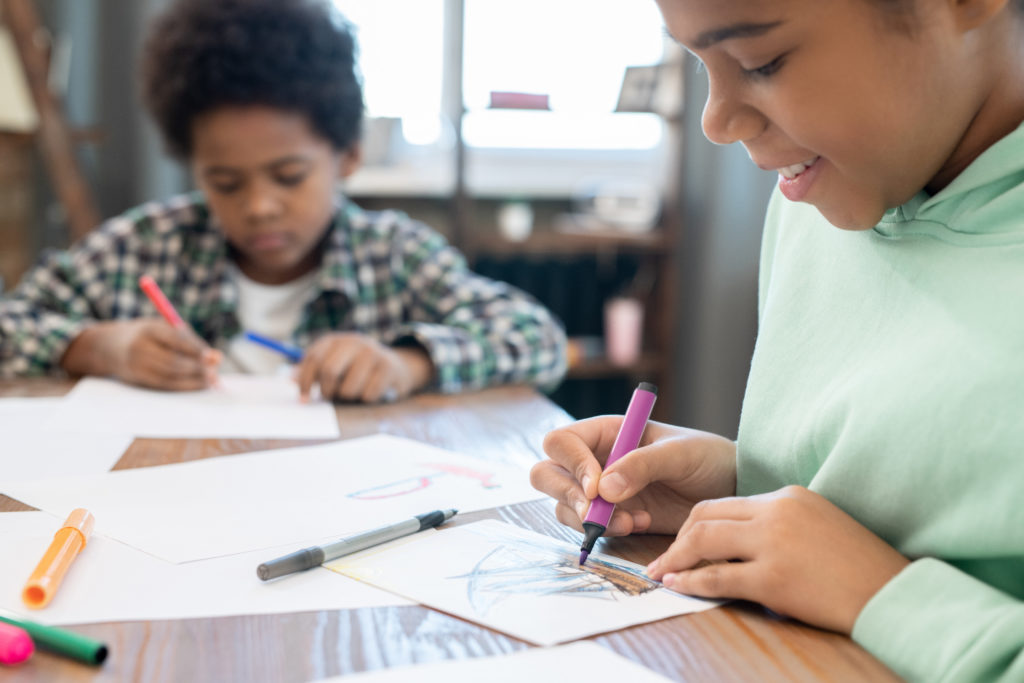How Art Therapy Impacts Emotions and the Brain

For children and adults who have experienced a traumatic event – who live with posttraumatic stress disorder (or PTSD) – the brain can often live in a state of hyperawareness, ready to flee or fight at the first sign of danger or distress.
Creative outlets like art and music have been shown to help counteract the way the brain processes trauma. Evidence suggests that individuals with trauma who participate in a creative activity routinely may even be able to rewire their brain to be more resilient and calm and less fearful and anxious.
The positive impacts of art therapy on individuals with PTSD have also been studied in U.S. veterans by the American Art Therapy Association which found that even individuals with complex trauma – those who experience multiple instances of trauma before the age of 6 – and those with PTSD reported lower rates of anxiety and stress and an increased ability to process and communicate about their trauma.
“To use the arts expressively means going into our inner realms to discover feelings and to express them through visual art, movement, sound, writing or drama. This process fosters release, self-understanding, insight and awakens creativity and transpersonal states of consciousness.” – Natalie Rogers, PhD, Registered Expressive Arts Therapist
While art therapy does not seek to replace the benefits and impact of traditional therapy and other forms of treatment for children and adults with PTSD and trauma, it can certainly benefit them.
The Benefits of Art Therapy for Children and Teens with Trauma
Research shows art therapy and creative mediums like painting, coloring, sculpting, and sketching can utilize areas of the brain which can help treat or counteract the effects of trauma and PTSD. Art therapy has been shown to:
- Improve focus
- Reduce stress
- Improve self-confidence, self-esteem, and self-awareness
When the body is stressed, the hormone cortisol is released into the bloodstream, having a residual impact on various areas of the body, including an increased heart rate, more blood flow, and rise in body temperature. While this response may have benefited our ancestors who needed adrenaline and cortisol to help them escape threats in the wild, modern day humans may experience this phenomenon in response to stress, which can lead to anxiety, panic attacks, and emotional outbursts.
“The arts empower. The arts give a voice to the voiceless. The arts help transform American communities and, as I often say, the result can be a better child, a better town, a better nation and certainly a better world. Let’s champion our arts action heroes, emulate them and make our communities everything we want them to be.” – Robert Lynch, CEO of Americans for the Arts
Through art therapy, creativity, and relaxation, hormones that calm and soothe the mind and body are released instead of cortisol and adrenaline. These “positive” hormones can counteract the effects of stress by rewiring the brain to recognize real and perceived threats (or past threats) as separate, distinct experiences – a process which can make someone with a history of trauma more resilient, more calm, and more self-assured.
Art Therapy at Palmer Home
For children who have experienced the trauma from adverse childhood experiences, like abuse, domestic violence, poverty, mental illness, and more, art therapy can truly be life changing.
In an effort to address the needs of the whole child through our Whole Child Initiative, Palmer Home offers art therapy to children and teens in our care to give them the best chance possible to thrive and to overcome trauma.
At Palmer Home, art therapy takes place in our state-of-the-art wellness center on our Hernando campus which houses both an art therapy space and a counseling suite in order to provide the best of every treatment option available for those we serve.
“There is belief that healing is possible through the arts. Imagine a child trying to participate in traditional talk therapy; hard to imagine right? You may ask, How can a child adequately communicate to achieve healing? This designated space in the Wellness Center will host a safe space for therapeutic expression through creative ways like art and play. This space and practice will allow a child to feel safe without the pressure to talk but still being able to express in a more age related environment.” – Raven Ponds, Director of Social Services at Palmer Home
Because of its benefits, art therapy is now a common technique employed by pediatric and adult therapists, and research suggests the younger a child experiences positive situations and emotions, the higher the likelihood they will experience a more resilient and less anxious adulthood. It is our hope that each and every child in our care can enjoy the therapeutic impacts of art therapy and a brighter future full of hope and healing.



